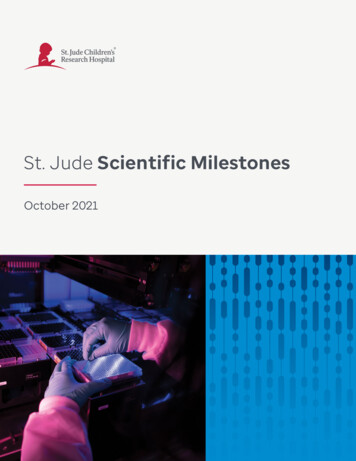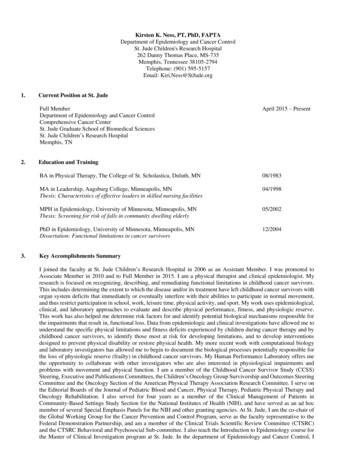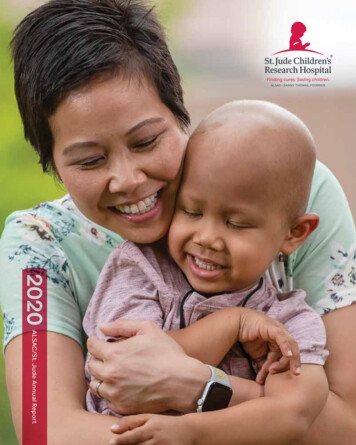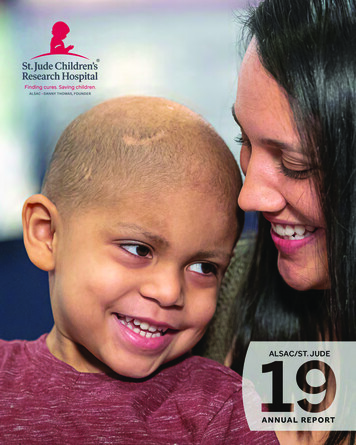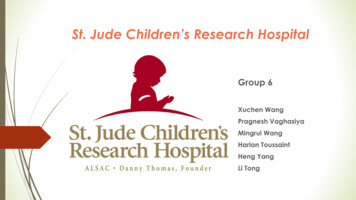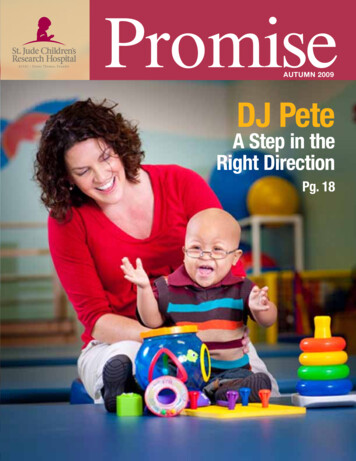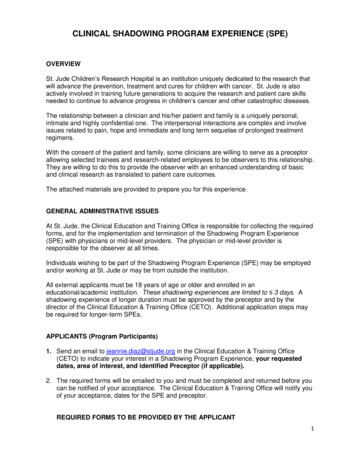
Transcription
2016–2021STRATEGIC PLAN
2ST. JUDE 2016–2021 STRATEGIC PLAN
ST. JUDE 2016–2021 STRATEGIC PLANTABLE OF CONTENTSMISSION3INTRODUCTION5GOALS AND OBJECTIVES6OUR CLINICAL CARE PRIORITIES7OUR RESEARCH PROGRAMS12OUR GLOBAL LEADERSHIP POSITION26RESOURCES REQUIRED TO ACHIEVE OUR VISION30APPENDICES33Privileged communication. Copyright 2015 St. Jude Children’s Research Hospital. No partof this communication may be cited, reproduced, stored in a retrieval system, or transmittedby electronic or other means without prior written permission of the hospital President andChief Executive Officer.ST. JUDE 2016–2021 STRATEGIC PLAN1
VISION FOR THE FUTURESt. Jude Children’s Research Hospital is aremarkable place of innovation with a legacy ofsuccess and a culture that allows it to achieve theextraordinary. Our focused vision of finding curesand saving children has led to the developmentof a world-renowned institution that has made alifesaving difference to countless families aroundthe globe.With the 2016–2021 Strategic Plan, St. Judehas an exciting blueprint on which to build theinstitution’s future. My gratitude is owed to theexecutive team, the more than 180 faculty andstaff, and the leadership of the Board of Governorsand ALSAC who lent their time, energy andtalent to help shape this new strategic plan. Theprograms detailed within this plan will help St. Judelead a new era of advancements in the researchand treatment of pediatric catastrophic diseases.James R. Downing, MDPresident and Chief Executive Officer2ST. JUDE 2016–2021 STRATEGIC PLAN
THE MISSION OF ST. JUDE CHILDREN’SRESEARCH HOSPITAL IS TO ADVANCECURES, AND MEANS OF PREVENTION,FOR PEDIATRIC CATASTROPHIC DISEASESTHROUGH RESEARCH AND TREATMENT.CONSISTENT WITH THE VISION OF OURFOUNDER, DANNY THOMAS, NO CHILDIS DENIED TREATMENT BASED ON RACE,RELIGION OR A FAMILY’S ABILITY TO PAY.ST. JUDE 2016–2021 STRATEGIC PLAN3
OUR VALUES ARE AN INTEGRALPART OF OUR IDENTITY AND GUIDE OURDAILY ACTIONS AND DECISIONS. THEINCORPORATION OF THESE VALUESDIRECTLY IMPACTS OUR ABILITY TOMAKE PROGRESS TOWARD ACHIEVINGTHE MISSION OF ST. JUDE CHILDREN’SRESEARCH HOSPITAL.EXCELLENCE: We embrace a culture ofexcellence, incorporating honesty, integrity andaccountability in every action and decision.INNOVATION: We foster an environment ofdiscovery, collaboration and creativity.COMPASSION: We demonstrate sensitivity tothe physical and emotional needs of our patients,families, staff and supporters.DIVERSITY: We respect ethnic, cultural, religiousand lifestyle differences of all people.4ST. JUDE 2016–2021 STRATEGIC PLAN
INTRODUCTION TO THE FY16–FY21STRATEGIC PLANSt. Jude Children’s Research Hospital is recognized as one of the leading medical institutions in the world.Central to its success is its focused mission to advance cures and means of prevention for pediatriccatastrophic diseases through research and treatment; its seamless integration of outstanding patient careand world-class clinical and laboratory research; its unique culture where every employee is part of a teamthat places the child and their family at the center of everything; and its financial strength and stability, whichstem from a unique structure of two interdependent but separate institutions, St. Jude and ALSAC, workingtogether with a highly engaged Board. We can be very proud of the legacy of accomplishments and thegreat work done every day to advance the St. Jude mission.As stewards of this extraordinary institution, however, we must continuously ask, “Are we doing enoughin the war against pediatric catastrophic diseases?” We are at a point in our hospital’s history where it isclear that we can do more. St. Jude has a unique opportunity to step up and become the recognized worldleader of pediatric medicine for the diseases we treat. In this role, we can establish a global clinical care andresearch agenda that will accelerate progress toward accomplishing our mission and improving lives forcountless families. St. Jude has the talent, institutional culture, resources and public support to effectivelylead the field.To address these goals, the institution embarked on a seven-month planning process to develop a newsix-year strategic plan (FY16–FY21). That process is described in Appendix I at the end of this document.Members of the Strategic Planning Oversight Group, the 15 Strategic Planning Working Groups, and theSt. Jude Board of Governors Strategic Planning Committee are listed in Appendix II.ST. JUDE 2016–2021 STRATEGIC PLAN5
OUR NEW SIX-YEARSTRATEGIC PLAN ISCENTERED ON 11SPECIFIC GOALS.OUR GLOBAL LEADERSHIP POSITION Expand our International Outreach Program sothat it can lead a global effort to ensure thatcures for pediatric cancer are rapidly madeavailable throughout the developing worldOUR CLINICAL CARE PRIORITIES Increase the number of patients treated onSt. Jude-led clinical trials both on our campusand around the globe to accelerate progress inadvancing cures, while minimizing therapyrelated toxicities Develop a St. Jude-funded global clinicalresearch consortium that can rapidly advancetherapeutic trials for pediatric cancer Set the standard for pediatric cancer caredelivery and the experience patients and theirfamilies have throughout their cancer treatmentjourneys Advance our clinical care programs for childrenwith non-malignant hematological diseases,including sickle cell disease, coagulationdisorders and bone marrow failure syndromesOUR RESEARCH PROGRAMS Strengthen our basic laboratory researchprograms, which serve as the foundation for ourunderstanding of disease pathogenesis andtherapeutic responses Enhance our clinical research programs andthe infrastructure that supports them so thatSt. Jude continues to effectively developand run high-complexity protocols thatadvance cures Establish the benchmark for the use of precisionmedicine in pediatric oncology for diagnosis,treatment selection, disease-response monitoring,diagnosing and managing therapy-relatedtoxicities and for identifying patients who wouldbenefit from cancer-surveillance screenings Determine the optimal application of protonbeam therapy in the treatment of pediatricpatients with brain tumors, solid tumors andHodgkin lymphoma Develop a world-class cancer immunotherapyprogram focused on pediatric cancers6ST. JUDE 2016–2021 STRATEGIC PLAN Organize global teams of scientists who willcollaboratively address high-priority scientificquestions identified as gaps in knowledge thatare currently limiting progress againstpediatric catastrophic diseasesIn the sections that follow, we detail theprograms required to achieve the 11 specificgoals. This strategic plan is based on the beliefthat St. Jude—with its history of achievement,exceptional faculty and staff, and supportfrom ALSAC and its millions of donors acrossthe United States—is poised for an era ofunprecedented discovery. As such, we must dowhat others cannot do. We must continually ask,“If not St. Jude, then who?”
OUR CLINICAL CARE PRIORITIESSt. Jude is committed to providing the best medical care and supportive services for children withhematological malignancies, brain tumors, solid tumors, non-malignant hematopoietic diseasesor select infectious diseases. Our models of care for the treatment of these diseases must set thestandards to which other institutions aspire. During the next six years, St. Jude will continue to focus75 percent of its overall efforts toward advancing cure rates for pediatric cancer and 25 percenttoward non-malignant hematological diseases and select infectious diseases.ST. JUDE 2016–2021 STRATEGIC PLAN7
ChildhoodCancerHematologySickle Cell DiseaseHemophiliaOthersInfectiousDiseasesFlu, HIVCancer PatientsPulmonaryThe St. Jude cancer program is one of the largest in the world. Our efforts during the last five decadeshave contributed to many of the advancements made in pediatric oncology. As a result, the overallcure rate for pediatric cancer today is 80 percent, with some cancers like acute lymphoblastic leukemia(ALL) exceeding 90 percent. Nevertheless, pediatric cancer remains the leading cause of death fromdisease among children ages 1 to 14 in the U.S. One in five children with cancer still succumbs to hisor her disease. Moreover, for some pediatric cancers, such as diffuse intrinsic pontine glioma, acutemegakaryoblastic leukemia and metastatic neuroblastoma, cure rates remain very low. In addition,survivors of pediatric cancer are at risk for a variety of long-term side effects, many of which are beingaccurately identified for the first time through the efforts of St. Jude. Our focus for the future mustbe not only to advance the cure rate for every child with cancer, but also to develop more tailoredtreatment approaches that will increase cure rates, while decreasing therapy-related toxicities.To accelerate progress during the next six years, St. Jude will make a concerted effort to enrollmore patients on St. Jude-led therapeutic and non-therapeutic clinical studies. Our faculty andstaff have the talent, creativity and infrastructural support to develop novel clinical protocols for themost aggressive forms of pediatric cancer. By increasing patient volume, we will be able to completeprotocols more rapidly and use our results to inform the next round of clinical innovation. To accomplishthis, we will need to expand the infrastructure for both clinical care and clinical research.On the next page, we describe the clinical care efforts required to effectively treat an expanded numberof patients on our campus. In the section titled “Our Research Programs” (page 12), we lay out theexpansion in research efforts that will drive progress in advancing cures, while decreasing therapyrelated toxicities. We then address our global leadership position and describe the significant expansionplanned in our International Outreach Program, the creation of a St. Jude-led Clinical ResearchConsortium and the development of global teams of scientists working collaboratively to address themost pressing scientific problems in the field of pediatric catastrophic diseases.8ST. JUDE 2016–2021 STRATEGIC PLAN
ENHANCING CAREON OUR CAMPUSBy FY21, our goal is to have a 20 percentincrease in the number of new cancer patientstreated each year on the St. Jude campus.This will require a substantial increase in theinfrastructure for clinical care delivery, includinggrowth in faculty and staff, expansion of inpatientand outpatient facilities, and new office spacefor the workforce involved in the multidisciplinarycare teams that are a hallmark of our clinical caremodels.Along with the planned expansions in workforceand facilities, St. Jude will further enhance itsfocus on quality and safety practices. We havenamed Dr. Pat Flynn as chief quality officer andDr. James Hoffman as chief patient safety officerto lead a team focused on education and theuse of data analytics to continuously improvethe quality and safety of the care we deliver. Theanalytic efforts will interact extensively with ourClinical Informatics group, allowing the institutionto take full advantage of the large data sets withinthe electronic medical record.IMPROVE THE PATIENTAND FAMILY EXPERIENCEPatients deserve the best treatment in a caringenvironment that makes their journeys ascomfortable and supportive as possible. We willevaluate the total patient and family experience,including initial contact with St. Jude, arrival oncampus, registration, clinic scheduling, waitingareas, methods of communication both on andoff campus, inpatient admissions, dischargeprocesses and housing. St. Jude will addressthis from the perspective of space planning,information systems, scheduling and processreengineering and will implement recommendedimprovements across the hospital’s operationalunits. With the move of all inpatients into theChili’s Care Center and the Kay Research andCare Center and the construction of a newoutpatient facility, St. Jude will be able to addressST. JUDE 2016–2021 STRATEGIC PLAN9
this in a holistic manner. A new Office of Patientand Family Experience will be established inFY16 and will be charged with leading the effortto reengineer the patient treatment journey atSt. Jude. This team will work closely with a newOffice of Strategic Planning and Decision Supportto conduct the detailed studies that will berequired to effectively introduce changes that willmost benefit patients and their families.A patient and family Town Square will beincorporated into designs for the new outpatientfacilities and renovated Patient Care Center. Thiswill be a one-stop center where families receiveassistance with their various needs, rangingfrom housing to travel requests to shopping forbasic items (both on-site and through an onlinepurchasing option) to assistance with reservationsfor local events. Together with the Family AdvisoryCouncil and our established culture of familycentered care, we can set the standard for theexperience patients and their families have as theymove through their cancer treatment.INCREASE RECRUITMENTOF PATIENTSOur goal is to become the center of choice forchildren with high-risk forms of cancer and selectnon-cancer diseases for which we have uniqueclinical trials. To better promote our clinical andresearch expertise, we will need to invest instrengthening our Physician/Patient ReferralOffice.St. Jude will also need to enhance its effortto directly inform families about the treatmentoptions available through our programs. A keyeffort toward accomplishing this goal will be todevelop a Web-based resource for the families ofchildren recently diagnosed with cancer. Thissource will inform parents about diseases,current treatment options, what St. Judeoffers and what treatment options canbe obtained within their local regions.This site will have a direct link to contactSt. Jude for consultation or referral andwill ensure that a hospital representativereplies within 24 hours. Our hope is to makethis website the only resource a family will needto visit for key information about pediatric cancer.Creation of such a site and the associatedconsultation service and informational efforts willrequire additional personnel, but will ultimatelyserve as an invaluable resource to parents ofpediatric cancer patients worldwide.1010 ST. JUDEST. 2016–2021 STRATEGIC PLAN
ENHANCE OURCLINICAL PROGRAMSFOR CHILDREN WITHNON-MALIGNANTHEMATOLOGICALDISEASESThe St. Jude clinical program will strengthenits efforts to provide children with the best careavailable, expand the number of therapeutic trialsavailable and develop a leading bone marrowtransplantation program for patients whosedisease severity requires this aggressive form oftherapy.Efforts to increase the number of patients treatedon our campus will extend to children with sicklecell disease, coagulation disorders and bonemarrow failure syndromes. Since its beginning,St. Jude has served as a prominent source ofcare for pediatric patients with sickle cell diseasein the greater Memphis area. Our program hasa legacy of innovation and is responsible for thefirst cure of sickle cell disease through allogeneicbone marrow transplantation. St. Jude must carrythis torch forward by continuing to advance themanagement of ongoing disease complications,while developing true cures.In conjunction with the University of TennesseeHealth Science Center and regional hospitalsystems, we will work toward enhancing the carereceived by our patients as they transition intothe adult care environment. We will also focus ourefforts on becoming an international referral centerfor children with coagulation disorders and bonemarrow failure syndromes. These latter effortswill significantly benefit from the Department ofHematology’s gene therapy program and ourexpanded efforts in genomic medicine that aredescribed in the next section.ST. JUDE 2016–2021 STRATEGIC PLAN 11
OUR RESEARCH PROGRAMSAt St. Jude, our responsibility is to learn from every patient treated on campus and to use thisinformation to advance treatment. This can only be achieved through the constant exchangeof information between the clinic and the basic research laboratories. Investigators must takeobservations made within the clinic and move them into fundamental studies within our researchlaboratories. Simultaneously, scientists must take observations and methodologies from the labs andmove them to the clinic. Only by combining outstanding patient care with sophisticated, biologicallydriven therapeutic trials will we accelerate progress in developing cures for pediatric catastrophicdiseases.12ST. JUDEJUDE 2016–20212016–2021 STRATEGICSTRATEGIC PLANPLAN12 ST.
ENHANCING BASICLABORATORY RESEARCHON OUR CAMPUSTo strengthen basic laboratory research,St. Jude will increase the number of itsfaculty dedicated to fundamental discoveryand enhance the infrastructure that supportslaboratory research. This effort has begunwith the creation of two new basic sciencedepartments: Cell and Molecular Biologyunder the leadership of Dr. J. Paul Taylor, andComputational Biology under the leadership of Dr.Jinghui Zhang. During the next six years, thesedepartments will recruit a total of 14 new facultyand more than 50 staff members. Their combinedefforts will enhance our understanding of thenormal biology of molecular, cellular andorgan systems and help define how alterationswithin these systems lead to diseases.St. Jude will also appoint new leadership tothe Departments of Developmental Neurobiologyand Structural Biology. During the last decade,these departments have been two of the mostprominent scientific forces within the institution.The fundamental work performed by theirST. JUDE 2016–2021 STRATEGIC PLAN 13
laboratories must remain at the cutting edgeof science and incorporate the most advancedexperimental systems and methodologies. Theirwork must be innovative, investigator initiated anddirected only by their commitment to advance ourunderstanding of human biology. The appointmentof new leadership for both departments will be apriority during the first two years of our strategicplan. Near the end of the strategic-planningprocess, we will need additional laboratoryspace to accommodate these and other growinglaboratory efforts. To meet these demands, we willbuild a new laboratory research building as part ofour six-year vision.A key interface between basic and clinicalscience is the Department of Chemical Biologyand Therapeutics (CBT). This effort has broughtgreat strength to the institution and has made asignificant impact on the kind of research pursuedat St. Jude. CBT has successfully engaged bothlaboratory and clinical investigators and is makingimportant progress to assess available drugs forpotential use in the treatment of pediatric cancers—an effort termed drug repurposing.During the next six years, our focus will be tocoordinate this work across campus. This willinclude efforts to gain early access to new agents,which are being tested in the clinic for usesunrelated to pediatric catastrophic diseases. Thedepartment will also expand its efforts to developchemical probes that can be used both to explorefundamental biological processes, as well as serveas lead compounds for drug development, which ifwarranted, could be pursued through partnershipswith pharmaceutical and biotechnologycompanies. Together, our preclinical-to-clinicaldrug development efforts will help define themost effective drugs and drug combinationsfor the treatment of pediatric cancer and othercatastrophic diseases.One new laboratory-based initiative that wasidentified through the strategic-planning processis to build a coordinated program that focuseson the biological processes that control geneexpression. We will recruit four new facultymembers to develop a cross-departmental programthat will not only broaden the scientific expertise oncampus but also complement the current work thatis being pursued in cancer biology, non-malignanthematopoietic diseases and infectious diseases.14TEGIC PLAN14 SST.T.JUDEPLANJUDE 2016–20212016–2021STRASTRATEGIC
Success in laboratory-based research requiresdeep scientific knowledge mixed with creativityand a fearlessness to tackle what are oftenbelieved to be unsolvable problems. Creatingan environment that fosters success requiresengaging individuals at different stages of theircareer, including experienced scientists as well asgraduate students. Bright graduate students bringenergy, a commitment to learn and a naiveté thatcan fuel new insights. St. Jude benefits from aclose relationship with the University of TennesseeHealth Science Center’s graduate program as wellas other informal arrangements with programsaround the world. We currently have 71 graduatestudents from universities across the nationpursuing their doctoral degrees on our campus.To further enhance the role of graduate studentsin laboratory-based research programs, St. Judewill establish a new graduate school for a PhD inbiomedical research. This program will capitalizeon the hospital’s unique and unparalleledtranslational research environment. The programwill take 10 to 12 students a year for four to fiveyears of graduate work, leading to a PhD. Formalplanning for this program has begun, and the goalis to have an initial entering class for FY18.ST. JUDE 2016–2021 STRATEGIC PLAN 15
ENHANCING CLINICALAND TRANSLATIONALRESEARCH ON OURCAMPUSSt. Jude was built on the idea that researchand clinical care are a continuum, and progresscan only be made by having world-classlaboratory investigators continuously interactingwith clinicians schooled in the science ofclinical investigation. To continue this legacy,we will strengthen and expand our clinical andtranslational research programs and the systemsthat support these efforts.St. Jude cancer research programsSt. Jude is the only National Cancer Institutedesignated Comprehensive Cancer Centersolely dedicated to pediatric patients. Underthe leadership of a new director, Dr. CharlesRoberts, the St. Jude Cancer Center containsone basic science program (Cancer Genetics,Biochemistry, and Cell Biology), one populationscience program (Cancer Prevention andControl), and three clinical/translational programs(Developmental Biology and Solid Tumors,Hematological Malignancies, and Neurobiologyand Brain Tumor). Strengthening our three clinical/translational programs is a top priority, which willbe accomplished by focusing on three interrelatedefforts: 1) elucidate the molecular mechanismsunderlying tumor formation, heterogeneity andtherapeutic resistance; 2) identify therapies thatexploit the identified molecular mechanisms;and 3) develop therapeutic trials based on theidentified biological principles, with a particularemphasis on refractory and relapsed disease.As part of this, St. Jude will expand its clinical trialportfolio to cover a broader range of molecularlydefined tumor subtypes. In addition, St. Jude willenhance its Phase I efforts to assess new drugs inthe treatment of pediatric cancers.An essential component of our clinical/translation research efforts will be to establishthe benchmark for the use of precisionmedicine in pediatric oncology for diagnosis,treatment selection, disease-response monitoring,diagnosing and managing therapy-related16 ST. JUDE 20162016––2021 STRASTRATEGICTEGIC PLANtoxicities and for identifying patients who wouldbenefit from cancer-surveillance screenings.St. Jude has taken a leading role in the NationalInstitutes of Health PharmacogenomicsResearch Network and has led clinical initiativesto incorporate host pharmacogenetic testinginto routine patient care at St. Jude through thePG4KDS protocol and internationally throughthe Clinical Pharmacogenetics ImplementationConsortium.The St. Jude Children’s Research HospitalWashington University Pediatric Cancer GenomeProject (PCGP) was a game changer in pediatriconcology. It helped to define new geneticsubtypes of pediatric cancer; gave new insightsinto the underlying genetic lesions that drive theformation of cancer, intra-tumor heterogeneity,metastatic behavior and therapeutic resistance;and led to the identification of potential newtherapeutic targets against which new agentscould be developed. The discoveryphase of the PCGP continues, and we haveincluded resources to not only continue tosequence additional pediatric cancersamples, but also to make sure the
extensive expertise developed through the projectis available to all basic and clinical researchprograms at St. Jude.A major challenge for the immediate future willbe to define how to move DNA sequencing intothe clinic. During the last 18 months, St. Judeestablished the infrastructure required for clinicalgenomics. We now have a CLIA-certified DNAsequencing laboratory, analytical pipeline and aninformatics environment that allows integratedinterpretation of DNA and RNA sequencingdata, as well as reporting of medically significantgenetic lesions identified in either tumor DNA orthe patient’s normal tissue. In addition, we havedeveloped a clinical genomics team of pediatriconcologists, molecular pathologists, medicalgeneticists, pharmacists, genetic counselors,ethicists, computational biologists and dataanalysts. This group works collaboratively toenroll patients, obtain tissue samples, performanalyses, interpret data and communicate theresults to patients, their families and their primaryphysicians.The St. Jude clinical genomics team andinfrastructure are second to none. Our precisionmedicine studies will be performed under a newclinical research protocol, Genomes for Kids,which opened in July of FY16. This is a feasibilitystudy to help establish the benchmark for theapplication of precision medicine to pediatriconcology. Based on the experience obtainedthrough this study, we will then move DNA-basedsequencing analysis into the routine workup ofevery cancer patient admitted toSt. Jude. It is our expectation that we will alsoextend this level of analysis to all consentingpatients enrolled in our collaborative clinicalresearch trials, including patients treated beyondour campus.ST. JUDE 2016–2021 STRATEGIC PLAN 17
During the next six years, St. Jude will initiate four new cancer-focusedprograms: (1) a clinical service dedicated to the diagnosis and care ofchildren with hereditary predispositions to cancer; (2) a national referralclinic for rare pediatric cancers; (3) a proton beam therapy program; and(4) a cancer immunotherapy program.18 ST. JUDE 2016–2021 STRATEGIC PLAN
1.TheCancer Predisposition Programunder the leadership of Dr. Kim Nichols, arecent recruit from the Children’s Hospitalof Philadelphia, will be an integral partof the St. Jude clinical genomics effort.Dr. Nichols will serve as the principalinvestigator of the Genomes for Kids(G4K) protocol. This program will managethe work-ups of all children expectedof having hereditary predispositions tocancer. It will also perform surveillancetesting so that the presence of anydeveloping cancer can be detected at theearliest possible time, when the chancesfor a cure are highest.Work performed as part of the PCGP hasdemonstrated that almost 10 percent ofSt. Jude pediatric cancer patients havegenetic lesions in their normal tissuepredisposing them to the development ofcancer. When these patients are identified,we will perform comprehensive genetictesting and offer counseling for the entirefamily. In addition, St. Jude will managethe care for any sibling found to carry agenetic lesion. We anticipate the G4Kprogram will grow significantly during thenext several years and by 2021, 200 to250 children annually will be under thecare of physicians and genetic counselorsfrom this program.2. Within the general classification ofpediatric solid tumors, a variety of raretumor types continue to have pooroutcomes. The rarity of each individualtumor type and the inability of anysingle institution to develop significantexpertise in its treatment contributeto poor outcomes. To advance curesfor these rare tumors, St. Jude willdevelop a referral clinic for rare tumors,bringing in patients from around theglobe beginning in early 2016. We willbegin this effort focused on pediatricmelanoma, a tumor type that is uniformlylethal once it spreads. Through thePCGP, researchers have made importantST. JUDE 2016–2021 STRASTRATEGICTEGIC PLAN 19
insights into the genetic lesions that drive thegrowth of pediatric melanoma. We will usethis information to develop new therapeuticprotocols and enroll a sufficient number ofpatients so that the studies can be completedas quickly as possible. St. Jude will not limitits efforts to melanoma but, over time, willexpand the clinic to include other rare typesof pediatric cancer. By developing this effort,St. Jude will accelerate improvements intherapy for some of the most aggressive andleast studied childhood tumors.3. In 2009, St. Jude started to use protonbeam radiation therapy to treat a subset ofits cancer patients through a collaborativearrangement. Patients have been treatedon St. Jude protocols at the Universityof Florida’s Proton Therapy Institute inJacksonville. At the same time, St. Judeinvested 100 million in building the St. JudeRed Frog Events Proton Therapy Center, astate-of-the-art proton therapy facility, whichwill treat its first patient before the end of2015. This center will contain three treatmentrooms equipped with uniquely advancedtechnology.Earlier this year, we appointed Dr. ThomasE. Merchant chair of the newly createdDepartment of Radiation Oncology. Underhis leadership, St. Jude will develop20 ST. JUDE 2016–2021 STRATEGIC PLANthe leading proton therapy program forchildren in the world. This program willincorporate advanced treatment and imagingmodalities with a sophisticated computationalinfrastructure so that St. Jude can define thebest use of this treatment for pediatric cancerpatients. We are convinced that protontherapy will offer better tumor control, whiledecreasing toxicities—an overarching
Chili's Care Center and the Kay Research and Care Center and the construction of a new outpatient facility, St. Jude will be able to address . 1010 . ST. JUDE ST. 2016-2021 STRATEGIC PLAN. this in a holistic manner. A new Office of Patient and Family Experience will be established in
